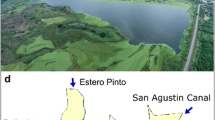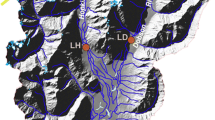Abstract
Varved minerogenic sediments from glacial-fed Blue Lake, northern Alaska, are used to investigate late Holocene climate variability. Varve-thickness measurements track summer temperature recorded at Atigun Pass, located 41 km east at a similar elevation (r 2 = 0.31, P = 0.08). Results indicate that climate in the Brooks Range from 10 to 730 AD (varve year) was warm with precipitation inferred to be higher than during the twentieth century. The varve-temperature relationship for this period was likely compromised and not used in our temperature reconstruction because the glacier was greatly reduced, or absent, exposing sub-glacial sediments to erosion from enhanced precipitation. Varve-inferred summer temperatures and precipitation decreased after 730 AD, averaging 0.4°C above the last millennial average (LMA = 4.2°C) from 730 to 850 AD, and 0.1°C above the LMA from 850 to 980 AD. Cooling culminated between 980 and 1030 AD with temperatures 0.7°C below the LMA. Varve-inferred summer temperatures increased between 1030 and 1620 AD to the LMA, though the period between 1260 and 1350 AD was 0.2°C below the LMA. Although there is no equivalent to the European Medieval Warm Period in the Blue Lake record, two warm intervals occurred from 1350 to 1450 AD and 1500 to 1620 AD (0.4 and 0.3°C above the LMA, respectively). During the Little Ice Age (LIA; 1620 to 1880 AD), inferred summer temperature averaged 0.2°C below the LMA. After 1880 AD, inferred summer temperature increased to 0.8°C above the LMA, glaciers retreated, but aridity persisted based on a number of regional paleoclimate records. Despite warming and glacial retreat, varve thicknesses have not achieved pre-730 AD levels. This reflects limited sediment availability and transport due to a less extensive retreat compared to the first millennium, and continued relative aridity. Overall, the Blue Lake record is similar to varve records from the eastern Canadian Arctic that document a cool LIA and twentieth century warming. However, the occurrence and timing of events, such as the LIA and Medieval Warm Period, varies considerably among records, suggesting heterogeneous climatic patterns across the North American Arctic.









Similar content being viewed by others

References
Abbott MB, Stafford TW (1996) Radiocarbon geochemistry of modern and ancient Arctic lake systems, Baffin Island, Canada. Quat Res 45:300–311. doi:10.1006/qres.1996.0031
Abramovich R, Pattee S (1999) SNOTEL network-analysis of and future plans for the collection of additional climatic parameters at SNOTEL stations. In: Proceedings of the western snow conference, pp 137–140
Anderson L, Abbott MB, Finney BP, Edwards ME (2005) Palaeohydrology of the Southwest Yukon Territory, Canada, based on multiproxy analyses of lake sediment cores from a depth transect. Holocene 15:1172–1183. doi:10.1191/0959683605hl889rp
Anderson L, Abbott MB, Finney BP, Burns SJ (2007) Late Holocene moisture balance variability in the southwest Yukon Territory, Canada. Quat Sci Rev 26:130–141. doi:10.1016/j.quascirev.2006.04.011
Besonen MR, Patridge W, Bradley RS, Francus P, Stoner JS, Abbott MB (2008) A record of climate over the last millennium based on varved lake sediments from the Canadian High Arctic. Holocene 18:169–180. doi:10.1177/0959683607085607
Blass A, Grosjean M, Troxler A, Strum M (2007) How stable are twentieth-century calibration models? A high-resolution summer temperature reconstruction for the eastern Swiss Alps back to AD 1580 derived from proglacial varved sediments. Holocene 17:51–63. doi:10.1177/0959683607073278
Blotzer L, Abbott MB, Bird BW, Finney BP, Ortiz JD, Patterson WP, Anderson L (2008) A 4,000-yr lake record of drought variability from Scout Lake, Yukon Territory, Canada. In: 38th international arctic workshop, Institute of Arctic and Alpine Research (INSTAAR), University of Colorado at Boulder, p 184
Calkin PE, Ellis JM (1980) A lichenometric dating curve and its application to Holocene glacier studies in the central Brooks Range, Alaska. Arct Alp Res 12:245–264. doi:10.2307/1550713
Clegg BF, Tinner W, Henderson A, Bigler C, Hu FS (2005) Spatial manifestation of the Little Ice Age in Alaska. Eos Trans AGU 86(52): Abstract PP31A-1513
Cockburn JMH, Lamoureux SF (2007) Century-scale variability in late summer rainfall events recorded over seven centuries in subannually laminated lacustrine sediments, White Pass, British Columbia. Quat Res 67:193–203. doi:10.1016/j.yqres.2006.10.003
Crowley TJ, Lowery TS (2000) How warm was the Medieval warm period? Ambio 29:51–54. doi:10.1639/0044-7447(2000)029[0051:HWWTMW]2.0.CO;2
Ellis JM, Calkin PE (1984) Chronology of Holocene glaciation, central Brooks Range, Alaska. Geol Soc Am Bull 95:897–912. doi:10.1130/0016-7606(1984)95<897:COHGCB>2.0.CO;2
Evison LH, Calkin PE, Ellis JM (1996) Late-Holocene glaciation and twentieth-century retreat, northeastern Brooks Range, Alaska. Holocene 6:17–24. doi:10.1177/095968369600600103
Fisher D, Wake C, Kreutz K, Yalcin K, Steig E, Mayeski PA, Anderson L, Zheng J, Rupper S, Zdanowicz C, Demuth M, Waskiewicz M, Dahl-Jensen D, Goto-Azuma K, Bourgeois J, Koerner RM, Sekerka J, Osterberg E, Abbott MB, Finney BP, Burns SJ (2004) Stable isotope records from Mount Logan, Eclipse ice cores, Nearby Jellybean Lake. Water cycle of the North Pacific over 2000 year and over five vertical kilometers: sudden shifts and tropical connections. Geogr Phys Quat 58:337–352
Francus P, Asikainen CA (2001) Sub-sampling unconsolidated sediments: a solution for the preparation of undisturbed thin-sections from clay-rich sediments. J Paleolimnol 26:323–326. doi:10.1023/A:1017572602692
Francus P, Keimig F, Besonen M (2002) An algorithm to aid varve counting and measurment from thin-sections. J Paleolimnol 28:283–286. doi:10.1023/A:1021624415920
Hardy DR (1996) Climatic influences on streamflow and sediment flux into Lake C2, northern Ellesmere Island, Canada. J Paleolimnol 16:133–149
Hodder KR, Gilbert R, Desloges JR (2007) Glaciolacustrine varved sediment as an alpine hydroclimatic proxy. J Paleolimnol 38:365–394. doi:10.1007/s10933-006-9083-9
Hu FS, Ito E, Brown TA, Curry BB, Engstrom DR (2001) Pronounced climatic variations in Alaska during the last two millennia. Proc Natl Acad Sci USA 98:10552–10556
Hughen KA, Overpeck JT, Anderson RF, Williams KM (1996) The potential for paleoclimatic records from varved Arctic lake sediments: Baffin Island, Eastern Canadian Arctic. The Geological Society, London
Hughen KA, Overpeck JT, Anderson RF (2000) Recent warming in a 500-year paleotemperature record from varves sediments, Upper Soper Lake, Baffin Island, Canada. Holocene 10:9–19. doi:10.1191/095968300676746202
IPCC (2007) Summary for policy makers. In: Solomon S, Qin D, Manning M, Chen Z, Marquis M, Averyt KB, Tignor M, Miller HL (eds) Climate change 2007: the physical science basis. Contribution of working group I to the fourth assessment report of the intergovernmental panel on climate change. Cambridge University Press, Cambridge
Jacoby GC, Workman KW, D’Arrigo RD (1999) Laki eruption of 1783, tree rings, and disaster for northwest Alaska Inuit. Quat Sci Rev 18:1365–1371. doi:10.1016/S0277-3791(98)00112-7
Kelly JS (1990) In: U. S. G. Survey (ed) Generalized geologic map of the Chandler Lake quadrangle, north-central Alaska. pp 1 sheet, 19 p
Lamoureux SF (1994) Embedding unfrozen lake sediments for thin section preparation. J Paleolimnol 10:141–146. doi:10.1007/BF00682510
Lamoureux S (2000) Five centuries of interannual sediment yield and rainfall-induced erosion in the Canadian High Arctic recorded in lacustrine varves. Water Resour Res 36:309–318. doi:10.1029/1999WR900271
Lamoureux S, England JH, Sharp MJ, Bush ABG (2001) A varve record of increased ‘Little Ice Age’ rainfall associated with volcanic activity, Arctic Archipelago, Canada. Holocene 11:243–249. doi:10.1191/095968301668776315
Leemann A, Neissen F (1994) Varve formation and the climatic record in an Alpine proglacial lake: calibrating annually laminated sediments against hydrological and meteorological data. Holocene 4:1–8. doi:10.1177/095968369400400101
Leonard EM (1985) Glaciological and climatic controls on lake sedimentation, Canadian Rocky Mountains. Z Gletsch Glazial 21:35–42
Mann DH, Heiser PA, Finney BP (2002) Holocene history of the Great Kobuk Sand Dunes, Northwestern Alaska. Quat Sci Rev 21:709–731. doi:10.1016/S0277-3791(01)00120-2
Maslanik JA, Serreze MC, Barry RG (1996) Recent decreases in Arctic summer ice cover and linkages to atmospheric circulation anomalies. Geophys Res Lett 23:1677–1680. doi:10.1029/96GL01426
Moore JJ, Hughen KA, Miller GH, Overpeck JT (2001) Little Ice Age recorded in summer temperature reconstruction from varved sediments of Donard Lake, Baffin Island, Canada. J Paleolimnol 25:503–517. doi:10.1023/A:1011181301514
Mysak LA, Venegas SA (1998) Decadal climate oscillations in the Arctic: a new feedback loop for atmosphere-ice-ocean interactions. Geophys Res Lett 25:3607–3610. doi:10.1029/98GL02782
Nesje A (1992) A piston corer for lacustrine and marine sediments. Arct Alp Res 24:257–259. doi:10.2307/1551667
Pienitz R, Smol J, Last WM, Leavitt PR, Cumming BF (2000) Multi-proxy Holocene palaeoclimatic record from a saline lake in the Canadian Subarctic. Holocene 10:673–686. doi:10.1191/09596830094935
Rabus BT, Echelmeyer KA (1998) The mass balance of McCall Glacier, Brooks Range Alaska, U.S.A.; its regional relevance and implication for climate change in the Arctic. J Glaciol 44:333–351
Reimer PJ, Baillie MGL, Bard E, Bayliss A, Beck JW, Bertrand CJH, Blackwell PG, Buck CE, Cutler SBG, Damon KB, Edwards PE, Fairbanks RL, Friedrich RG, Guilderson M, Hogg TP, Hughen AG, Kromer KA, McCormac B, Manning FG, Ramsey SW, Reimer CB, Remmele RW, Southon S Jr, Stuiver M, Talamo S, Taylor FW, van der Plicht J, Weyhenmeyer CE (2004) IntVal04 Terrestrial radiocarbon age calibration, 26-0 ka B.P. Radiocarbon 46:1029–1058
Rigor IG, Colony RL, Martin S (2000) Variation in surface air temperature observations in the Arctic, 1979–97. J Clim 13:896–914. doi:10.1175/1520-0442(2000)013<0896:VISATO>2.0.CO;2
Sikorski JJ, Kaufman DS, Manley WF, Nolan M (2009) Winter accumulation at the equilibrium line of Little Ice Age glaciers, Brooks Range, Alaska. Arct Antarct Alp Res 41(1)
Smith SV, Bradley RS, Abbott MB (2004) A 300 year record of environmental change from Lake Tuborg, Ellesmere Island, Nunavut, Canada. J Paleolimnol 32:137–148. doi:10.1023/B:JOPL.0000029431.23883.1c
Stafford JM, Wendler G, Curtis J (2000) Temperature and precipitation of Alaska: 50 year trend analysis. Theor Appl Climatol 67:33–44. doi:10.1007/s007040070014
Stroeve J, Serreze M, Drobot S, Gearheard S, Holland M, Maslanik J, Meier W, Scambos T (2008) Arctic sea ice extent plummets in 2007. EOS 89:2 pp
Stuiver M, Reimer PJ (1993) Extended 14C database and revised CALIB radiocarbon calibration program. Radiocarbon 35:215–230
Wright HE, Mann DH, Glaser PH (1984) Piston corers for peat and lake sediments. Ecology 65:657–659. doi:10.2307/1941430
Acknowledgements
This research was funded by the National Science Foundation as part of the ARCSS 2 kyr project, award #ARC0454941. We extend special thanks to Erik Rapoport Esq., Toby Schwoerer, Dan Nelson, and Byron Steinman for their invaluable assistance in the field. We also acknowledge the staff of the Limnological Research Center at the University of Minnesota for their assistance with core processing and imaging. Finally, we thank the three anonymous reviewers and Darrell Kaufman for their comments, which greatly strengthened the quality of the manuscript.
Author information
Authors and Affiliations
Corresponding author
Additional information
This is one of fourteen papers published in a special issue dedicated to reconstructing late Holocene climate change from Arctic lake sediments. The special issue is a contribution to the International Polar Year and was edited by Darrell Kaufman.
Rights and permissions
About this article
Cite this article
Bird, B.W., Abbott, M.B., Finney, B.P. et al. A 2000 year varve-based climate record from the central Brooks Range, Alaska. J Paleolimnol 41, 25–41 (2009). https://doi.org/10.1007/s10933-008-9262-y
Received:
Accepted:
Published:
Issue Date:
DOI: https://doi.org/10.1007/s10933-008-9262-y



